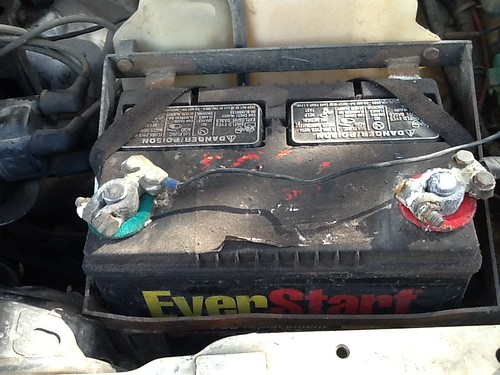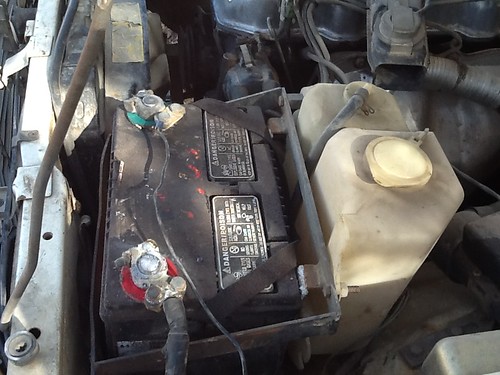<p style="margin-bottom: 0in;">Hi Michelle, I noticed your question and wanted to offer some assistance. Lostinspace raises a very good point about internet retailers and warranty service. Most batteries must be returned to their original retailer for warranty service, including online retailers. Not everyone who sells batteries online is an authorized retailer either, including some very popular sites. That means if you do need warranty assistance, you may be on your own if you choose the wrong retailer. </p><p style="margin-bottom: 0in;">If you live anywhere near a Walmart, you are also probably near an Interstate Batteries dealer, so you do have some options (there are five different Interstate dealers in Sheridan). Some big box retailers and just about any place that does oil changes will also install a battery for you. </p><p style="margin-bottom: 0in;">As others have indicated, your house battery should be designed for deep-cycle use. Most automotive batteries are SLI (starting/lighting/ignition), but you want an auxiliary battery that can be discharged more deeply and recharged multiple times with minimal performance loss. Not all marine batteries are designed for deep-cycle use and if you look closely at at marine batteries, you'll see the only differences between many of them and their automotive counterparts are threaded terminals, a shorter warranty and a higher price tag. </p><p style="margin-bottom: 0in;">I know how confusing all the different electrical terms can be, but I've always thought this cartoon did a pretty good job of explaining their relationship to each other- </p><p style="margin-bottom: 0in;"><img rel="lightbox" src="
http://media-cache-ec5.pinterest.com/originals/6b/3a/d1/6b3ad1a95e461bf88ceb13d70cb57e0a.jpg" class="bbc_img"><br>When you are shopping for a battery, you should know what size battery will fit the space you have available. Batteries have really weird BCI Group sizes that don't necessarily correlate to the actual size of the battery, but are universal across brands. For instance, a Group 31 battery is the largest we make, but it is physically smaller than a Group 34 and physically larger than a Group 27. Your battery size should be printed on the label on the top of the battery, along with the specifications for your battery- CA (cranking amps) CCA (cold cranking amps) RC (reserve capacity).<br><br>You should select a battery that meets or exceeds the specifications of the battery you are replacing. However, some folks may try to sell you on getting a battery with more cold cranking amps (CCA), because they equate more CCAs with more power. For an auxiliary (house) battery, your primary concern is reserve capacity and not cranking amps and a battery's ability to be deep-cycled. Reserve capacity gives you an idea of how long the battery can provide a constant rate of energy. Cranking amps is more about the amount of power a battery can provide in short bursts.<br><br>Page 31 of your manual appears to show another battery, which may be the house battery. That would be the battery that would likely power your accessories when the engine is turned off. House batteries tend to be larger than the battery under your hood that is used to start your truck. Generally speaking, the larger a battery is physically, the more reserve capacity it will offer and the longer you'll be able to run accessories off battery power.<br><br>The battery in the picture is probably a flooded battery, as it shows caps, where water can be added. They are called "flooded" batteries, because the lead plates are suspended in an electrolyte solution, versus a "dry" battery, like the AGM (absorbed glass mat) batteries previously mentioned, which have the electrolyte solution absorbed in the glass matting in between the plates. Flooded batteries can leak acid if you tip them over, while AGM batteries are "sealed" and can actually be mounted on their sides without spilling acid.<br><br>Most automotive batteries are flooded, because flooded batteries are cheaper. While AGM batteries are more expensive, they can last up to twice as long. Their low internal resistance (OHM, the guy tugging on the rope) also allows them to deliver more current (AMP, the guy getting kicked in the butt) for longer periods of time, than their flooded counterparts.<br><br>Even though we're talking about 12-volt batteries, I should explain that most batteries are more than 50% discharged if they only measure 12.0 volts. Our RedTops are fully-charged at about 12.6-12.8 volts, while our YellowTops are fully-charged at about 13.0-13.2 volts. If you've been using your house battery for long periods of time, it is a good idea to fully-charge it by plugging it in (versus using your truck's alternator), as soon as you can. <br><br>I know that is a lot of information to digest, but I'm happy to answer any questions I can for you, so feel free to ask anything.<br><br>Jim McIlvaine<br>eCare Manager, OPTIMA Batteries, Inc.<br>
www.pinterest.com/optimabatteries</p>






